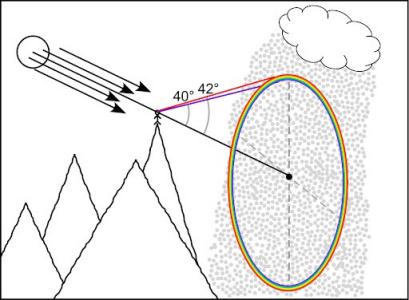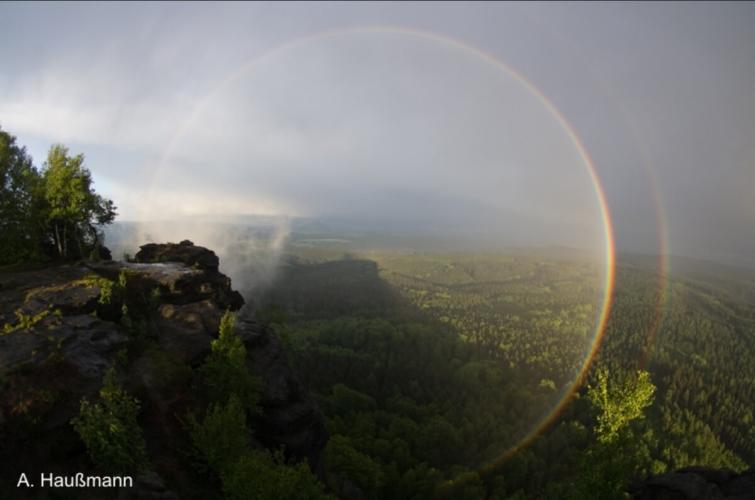Primary Rainbows
Bright unobscured sunlight and rain are necessary for rainbows, but the position of the sun and the rain are also important.
Relationship to the Viewer
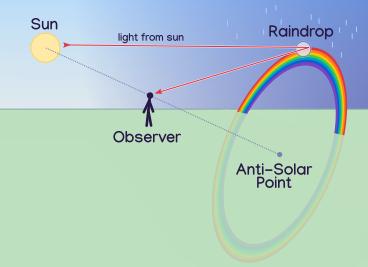
A rainbow is not in a static position in the sky, rather it depends on the viewers angle with the sun. The sun, the viewer, and the antisolar point lie on the same line, with the viewer in the middle. The center of the rainbow is the "antisolar point" which is always directly across from the sun. Each person will see a slightly different rainbow since they each make a different line with the sun, creating a different point for the antisolar point.
So why must a rainbow be opposite of the sun?
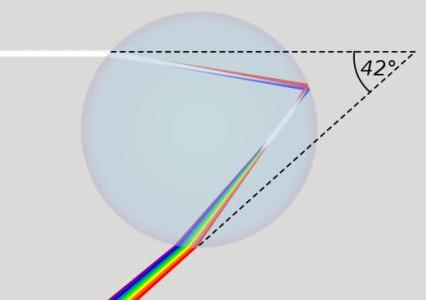
Here is white sunlight entering a drop of water and exiting as rainbow colors of light. The important thing to note here is how the light reflects off of the back of the waterdrop, directing it back from where it came (but at an angle).
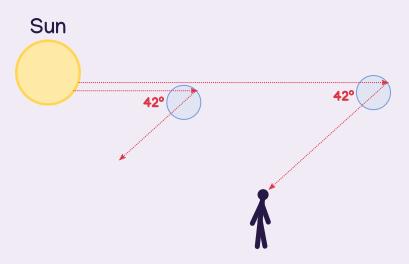
So in order for a person to see the bow, light has to reflect off of raindrops on the other side of the sky. Light is reflected from other drops, but it's simply not directed towards us, so we don't see it (much like how we don't see the ray of a laser, just its point).
In fact it may help to think of all the water droplets like tiny mirrors and the sun as a laser. The rays reflect off of the tiny mirrors which are angled the same, and "land" parallel to each other in different points on the ground (according to the mirrors position in in the sky). If it happens to land on someones eye, they can see the red of the laser glinting off of that mirror. Of course that would only be one point in the sky, but the spherical shape of waterdrops allows light to reflect to us from drops positioned in circles rather than just one drop. Each wavelength of color also makes a slightly different angle, so the different colors are actually reflected by different drops! This is also why different people see different rainbows, since each person will see a rainbow made by different water droplets.Rainbow Cone - AtOpt The further away the droplets are, the less obvious this is however.
Rainbows are always full circles, but the entire circle is usually obscured "by" the ground. A rainbow can sometimes be seen between the viewer and the ground, but there are rarely enough suitable raindrops there. High vantage points like hills or mountains allow the viewer to see farther across the land, increasing the amount of raindrops seen under the horizon, thus rainbows can be seen over the ground. However, it is much easier to observe a rainbow between oneself and the ground by using a garden hose on a spray setting.
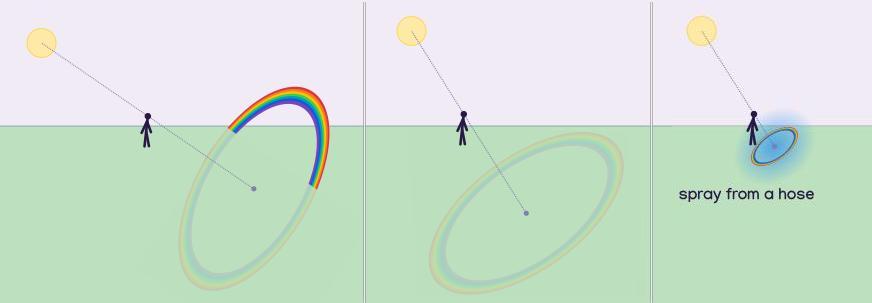
The higher the sun is, the lower the rainbow isLow and High Bows - AtOpt, since the middle of the rainbow must directly oppose the sun. This means that if the sun is too high, we will not see a rainbow regardless of optimal rain and bright sunlight. The exception is using a garden hose to spray water droplets between the ground and the viewer. The rainbow from a hose may look small in the illustration, but it still takes up a large range of our vision.

On the otherhand, the amount of rainbow visible can increase if the sun is lower to the horizon or the viewer is higher (a full circle can be seen from a plane). Despite the ground being visible behind the rainbow, the full circle is visible because there are enough raindrops between the ground and viewer.
A viewer may also be able to see an entire rainbow while on a mountain, if there is enough rain between the viewer and the distant background.
Here is a real life view of what a rainbow from a mountain top looks like! Part of the land is infront of the raindrops, but a lot is visible.
Note that rainbows are always near perfect circles, they cannot be seen from an angle like they are in these diagrams, since the observer is always directly between the sun and antisolar point.
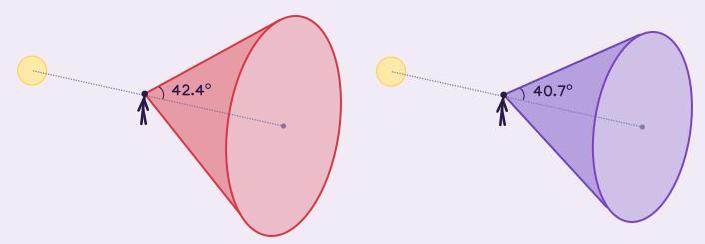
Just like a rainbow is not a fixed position in the sky, a rainbow is also not a specific distance away from the viewer. Essentially an infinite cone is formed with the viewer at the point and the rainbow as the surface of the cone around the antisolar line as an axis. The waterdrops that fall within this cone are the ones that will reflect light into the observer's eye. As long as there are water droplets on the cone's surface, a rainbow can be seen whether the droplets are feet or miles away. Their distance does not impact the appearance of the rainbow. Each person has their own cone that waterdrops will reflect.Rainbow Cone - AtOpt
Each color has its own cone, with red being the largest and violet being the smallest. Red is at ~42 degrees away from the antisolar axis, on the very outside edge of the rainbow, violet is at ~40 degreesLibreText Physics. This angle corresponds to the angle that each wavelength of light makes on exitting a drop compared to the entrance light. Red is least affected by refraction, so it makes the widest angle, violet is most affected by refraction, so it makes the sharpest angle.
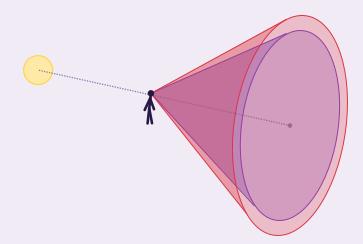
The smaller cones nest inside of the larger cones. This diagram shows just violet and red for clairity but the rest of the colors are inbetween. Since there are an infinite amount of wavelengths (we can have wavlengths with decimals like 534.72nm), these cones blend into each other.
Note that the we are always looking at this cone through the central axis, so we always see it as just a circle.
Caustics
So why is it a hollow cone of waterdrops that reflect light to a single point? Lets first look back at prisms.
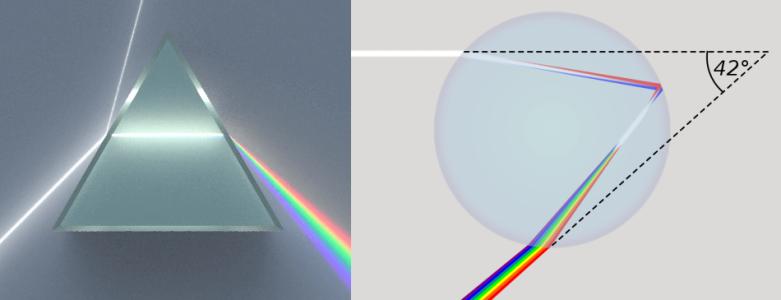
Notice in this diagram, how the light passes through the prism, but reflects on the inside surface of the water drop. Light does infact pass straight through a water drop like it does through a prism, but the shape of the drop does not allow the dispersed light to form a rainbow, despite the droplet acting as a prism. These rays of light wash each other out, creating extra brightness around the sun (zeroth order glow).Rainbow Caustics
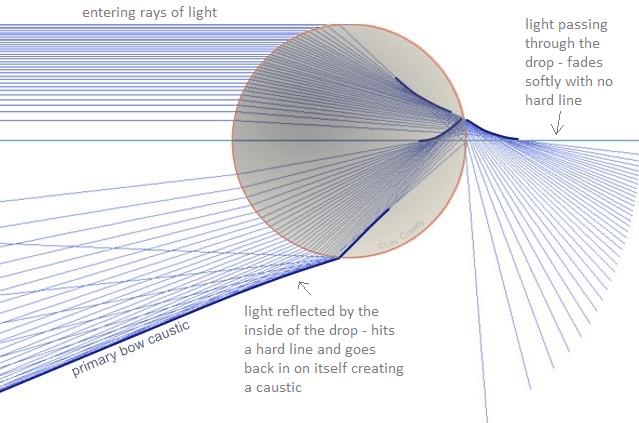 Rainbow Caustics - AtOpt - annotatted by me
Rainbow Caustics - AtOpt - annotatted by me
Light rays passing through the drop will exit on the other side (right) so that they all flare outwards from each other without hitting any boundaries. They go in different angles because they enter the drop at different points, making different angles according to the drops surface. Hitting the middle of the drop they go straight through without bending, hitting near the top they bend the most due to refraction.
Light that is reflected by the inside surface of the drop exit on the same side they entered (bottom left) and start to flare from each other, until a certain point. They hit a hard line, and start to flare up over the others. This creates a caustic which is a physics phenonema describing distinct areas or lines where light rays are densely packed. Caustics are not made by rays that pass through the drop without reflecting.
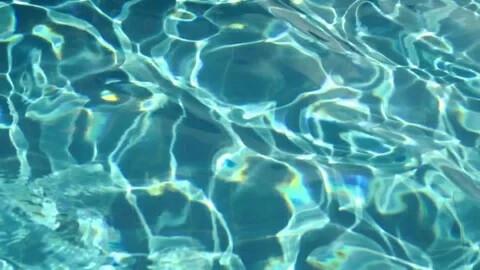
Caustics are frequently observed in clear water on a sunny day, where light collects into thin shimmery lattices on the bottom of the pool, like this one.
Here in a drop we can see the hard line where the reflected rays will not cross, where light collects in a caustic. This is also called the minimum angle of deviation. Considering drops are 3D spheres and not flat circles, these lines result in a 3D cone for each color.
Each wavelenghth of light creates a caustic at a slightly different angle from the recieved sunlight, allowing the larger angles (red) to be seen outside of the smaller angles (violet). How Rainbows Form

Each wavelength will produce light that is very faint around the antisolar point (central axis), concentrating until the edge of the cone, the caustic where it is a very intense thin line. And since each wavelength creates a different sized caustic, the smaller colors show through the transparent areas of the larger colors. The areas of faint color glow are created by the rays of light that are above the caustic line in the drop diagram; there are far fewer of them, so they only create a soft glow.
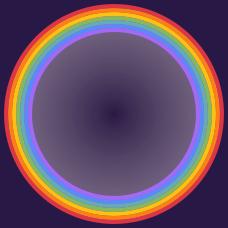

Here they are overlapped to form the rainbow. Note that the outer colors inner glow overlaps the inner colors, washing them out slightly. The faint glow on the inside of each color also overlaps to form a glow on the inside of the whole rainbow.
Suggested next page: Secondary and Higher Order Rainbows
